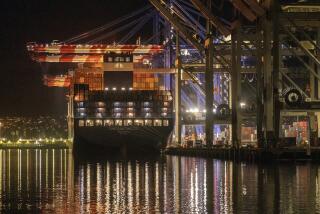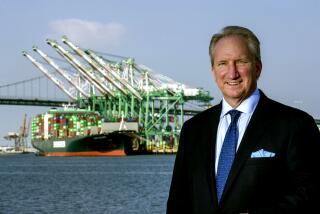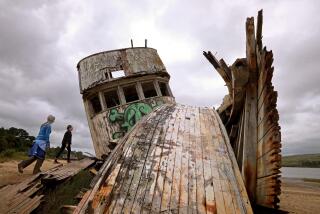Falling Tide : Local Boat Builders Look Back at Good Old Days
Although Ventura County spans 45 miles of coastline and sports three harbors--including the only deep water port between Los Angeles and San Francisco--the boat building industry is on the decline here, officials said.
There are only about six companies in the county that build commercial and recreational boats, down from a peak of 10 firms in the early 1980s, boat builders said.
“It’s not like in the old days, when people wanted custom-designed boats,” said Jerry Scotton, a longtime Oxnard boat builder. “There’s just no market for them anymore.”
Boat building has never been a major industry here, as it is in Los Angeles, Orange and San Diego counties, where most of California’s 1,000 boat manufacturers are based, said Mike Evans, a spokesman for the Southern California Marine Manufacturers Assn.
But the number has recently dwindled, partly because the increasing cost of real estate forced many small businesses to move out of the county, where property is cheaper. Other boat builders have moved south, where the highest concentration of boat owners are found, Evans said.
Nearly half of the state’s 6.47 million boats are registered in Los Angeles, Orange and San Diego counties, compared with fewer than 20,000 registrations in Ventura County, he said.
Another reason for the decline in boat building is that boaters are now more interested in zooming across the relatively calm waters of inland lakes, the traditional haven of speedboats, rather than braving the unpredictable seas off Ventura’s coast, Evans said.
With few inland waterways to speak of, Ventura simply is not a boater’s paradise, despite the proximity of the sparkling blue waters of the Pacific Ocean, which can be reached through the Channel Islands Harbor in Oxnard, the Ventura Harbor and the Port of Hueneme--the deepest harbor between San Francisco and Los Angeles.
Where once the only way to buy a boat was to commission one, customers can now choose from an array of prefabricated models.
“The business is kind of dying here,” Scotton said. Until recently, Scotton has built two or three boats a year, including an 88-foot commercial fishing boat that took six months to build. Now he has to rely on sporadic requests to repair and maintain boats stored at the Channel Islands boatyard to supplement his income, he said.
At the height of business in the early 1980s, Scotton said, he employed up to 20 assistants in his Oxnard boatyard to help build three or four boats at a time. Now he said he is not building anything and spends most of his time leading fishing and hunting tours in Monterey County.
High property values have also chased many builders from the county’s marinas to less expensive inland sites. Since 1980, at least four boat builders have closed shop, either moving elsewhere in the state or giving up the business altogether, according to those who have remained.
Most of the county’s boat builders, such as Gerald Pohl of Ventura, now work in old warehouses and large parking lots far from the water’s edge.
“Land is too expensive to set up a business near the water,” said Pohl, who builds the heavy-duty aluminum boats popular among the Coast Guard and other government agencies. The boats are built in a warehouse on Golf Course Drive in Ventura and hauled by trailer to launching pads.
Lower gasoline prices have also fueled a resurgence in the popularity of speedboats, further eroding the demand for custom boats, which are typically more expensive then factory-built models.
“The market is in hot-rod speedboats,” said Bob Olsen, a spokesman for the U.S. Coast Guard. “People want the kind of fast boats they can buy off a showroom floor.”
Nevertheless, there is still a demand for custom steel and wood boats, area builders and designers said.
Jeffrey Blume, a Ventura boat designer who has a degree in naval architecture from UC Berkeley, has designed several commercial fishing boats and a water taxi for use off Ventura County’s coast.
“There is a core group of boaters in this area who are interested in a special kind of boat that is custom-designed to fit their needs,” Blume said.
Boats used in the rough waters off the Channel Islands must be able to withstand continued slamming of waves, he said. Boats also need thick bottoms to resist the wear and tear of frequent beach landings.
Island Packers, a boating company that takes passengers to the Channel Islands National Park, has bought five of its nine boats from local builders, owner Mark Connally said.
“You get a lot more quality in a custom boat than in a pop-out model,” Connally said. “It’s also easier to keep track of the work when it’s being done in your own back yard.”
The company recently turned to Waterfront Fabricators in Ventura when it needed a 19-foot aluminum landing skiff. Light enough to be pushed off the sandy beaches of Santa Rosa and San Miguel islands, the boat also has sides high enough to block incoming water and prevent passengers from falling overboard, Connally said.
“A factory boat wouldn’t even come close to our needs,” he said.
One advantage of a custom-built boat is that it can be designed to accommodate local conditions, builders say. For instance, one of Blume’s latest designs, a 65-foot charter boat named the Vanguard, is built to withstand high seas and yet be light. Commissioned by Glen Galbraith, a local fisherman, to replace a smaller boat, the Vanguard is expected to cost about $250,000 when it’s complete.
“All boats are a compromise. You build it, you run it, and you find out what you’d rather have,” said Galbraith, running his hand over the unfinished hull he is building in a cluttered parking lot behind Oxnard Airport.
Made of mahogany plywood molded to a frame with epoxy rather than screws, the Vanguard will carry 49 passengers for day use with overnight berthing for 25. It will be 10 feet longer and two feet wider than Galbraith’s last boat, the Morningstar, which was sold to a local fisherman.
The desire for bigger and better boats doesn’t necessarily mean more are built and designed, Blume said. Many custom boats, such as the Morningstar and perhaps eventually the Vanguard, simply trade hands among a small group of people.
“There will always be people who want to own something original, but most people like to buy what they can see” in the showroom and in a harbor slip, Blume said.
More to Read
Inside the business of entertainment
The Wide Shot brings you news, analysis and insights on everything from streaming wars to production — and what it all means for the future.
You may occasionally receive promotional content from the Los Angeles Times.










